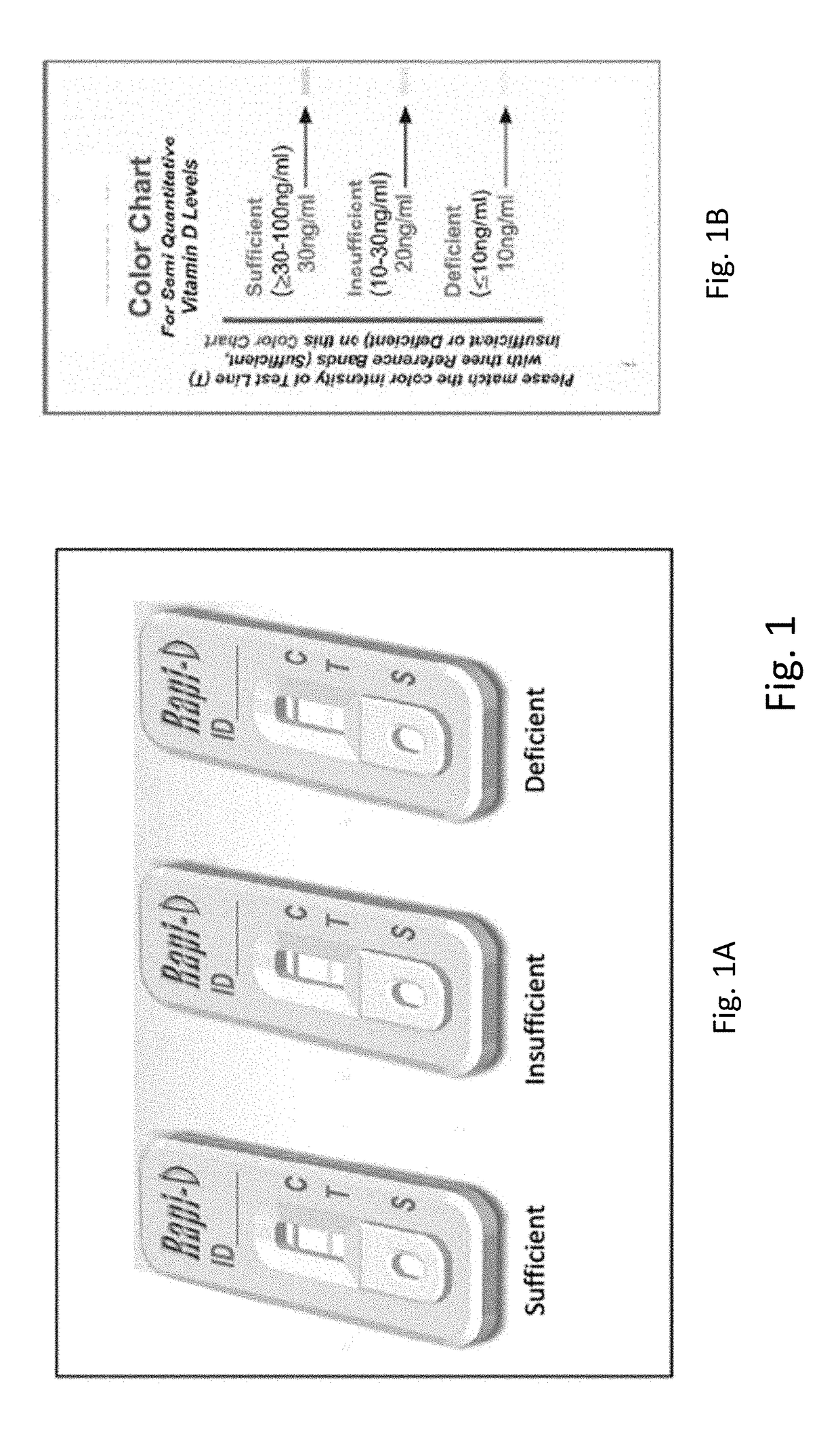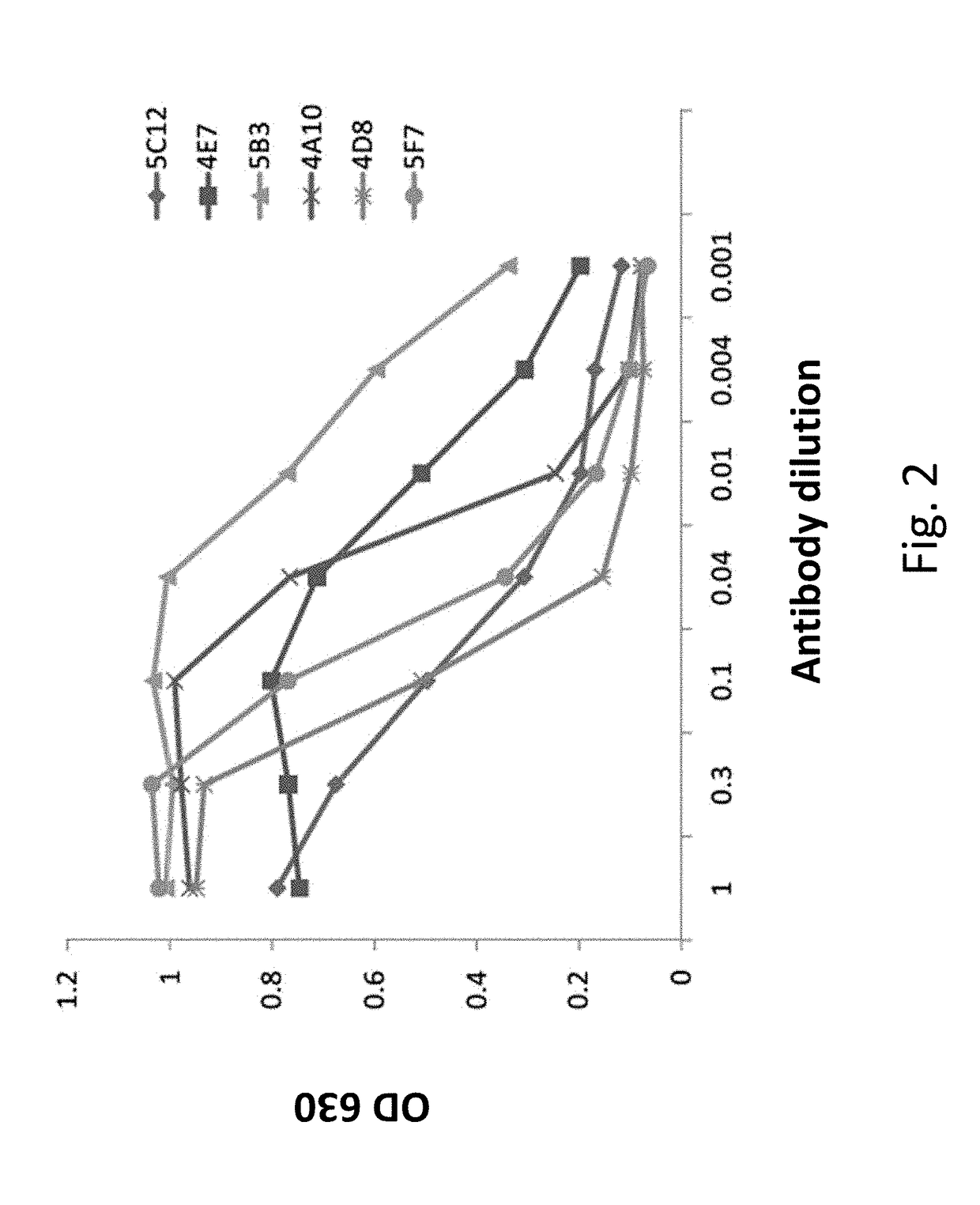Device for Detection of Vitamin D Metabolites
a technology of vitamin d and metabolites, applied in the field of steroid hormones, can solve the problems of increasing mortality risk, becoming a global epidemic, and estimated 1 billion people worldwide do not have adequate vitamin d levels
- Summary
- Abstract
- Description
- Claims
- Application Information
AI Technical Summary
Benefits of technology
Problems solved by technology
Method used
Image
Examples
example 1
Generation of Monoclonal Antibody to 25-(OH)D
[0089]Monoclonal antibodies against 25-(OH)D were prepared by a modified method of Kohler and Milstein (G. Kohler and C. Milstein Nature, 1975, 256, 495). Mice were immunized by subcutaneous injection of 25-(OH)D conjugated at its 3-position to carrier protein KHL. The complete Freund's adjuvant was injected with the antigen. The incomplete Freund's adjuvant was used for antigen boosts. The immune response was monitored by ELISA against 25-(OH)D3. After four to five antigen boosts, the spleen cells were harvested and fused with myeloma cells in the presence of polyethylene glycol (PEG). The fused cells were seeded in 96-well plates and grown in the presence of selective hypoxanthine, aminopterin and thymidine (HAT) medium. The supernatants from the fused cells were tested by ELISA for binding activity to 25-(OH)D3 and 25-(OH)D2. The clone AF10, which has a high affinity for binding both 25-(OH)D3 and 25-(OH)D2, was selected for large scal...
example 2
Generation of a Monoclonal Antibody Against an Immunocomplex of 25-(OH)D and mAb From Immunized Mice
[0090]Mice were immunized by subcutaneous injection of 25-(OH)D conjugated at its 26-position to carrier protein keyhole limpet hemocyanin (KLH). The complete Freund's adjuvant was injected with antigen. KLH conjugate and the incomplete Freund's adjuvant was used for the first and third boosts, and the immunocomplex of 25-(OH)D:antibody AF10 was used for the second and fourth boosts. The immune response was monitored by ELISA assay to the immunocomplex of 25-(OH)D:antibody AF10. After 4 boosts, the spleen cells were harvested. The RNA from the spleen cells was then isolated and variable gene amplification was performed.
[0091]The mRNA was isolated by using Dynabeads® mRNA Purification Kit (ThermoFisher) according to the manufacturer's protocol. Subsequently, first strand cDNA was generated using Superscript II reverse transcriptase (Invitrogen, Carlsbad, Calif.). From the cDNA, heavy a...
example 3
Generation of a Monoclonal Antibody to the Immunocomplex of 25-(OH)D:mAB From a Synthetic Library
[0108]The synthetic antibody library was designed based on the natural VH / VL pairing frequency (described in Protein Engineering, Design & Selection pp. 1-7, 2012 doi:10.1093 / protein / gzs043), the frameworks of frequently paired human VH1, VH3, VK1, VK3, Vλ1, VX2 and Vλ3 were selected as master genes for gene synthesis. The selected master genes were synthesized by PCR assembly of overlapping oligos. The length of oligos was between 60 and 80 bases, and the oligos for all CDRs were degenerate oligos using the nucleotides NNS and / or MVS to randomize amino acid residues. After the first round of PCR assembly, 5 light chain master genes were assembled with a light chain constant region by PCR. The resulting full-length light chain genes were digested with restriction enzymes HindIIII and Ncol (New England Lab) and size-selected on a 1% agarose gel. The size-selected fragments were purified a...
PUM
| Property | Measurement | Unit |
|---|---|---|
| concentration | aaaaa | aaaaa |
| OD | aaaaa | aaaaa |
| temperature | aaaaa | aaaaa |
Abstract
Description
Claims
Application Information
 Login to View More
Login to View More - R&D
- Intellectual Property
- Life Sciences
- Materials
- Tech Scout
- Unparalleled Data Quality
- Higher Quality Content
- 60% Fewer Hallucinations
Browse by: Latest US Patents, China's latest patents, Technical Efficacy Thesaurus, Application Domain, Technology Topic, Popular Technical Reports.
© 2025 PatSnap. All rights reserved.Legal|Privacy policy|Modern Slavery Act Transparency Statement|Sitemap|About US| Contact US: help@patsnap.com



